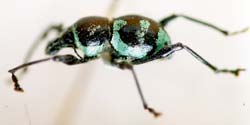

The gemstone opal could be manufactured synthetically copying a technique employed by a beetle to control the appearance of its outer shell.
Researchers from the Department of Zoology at the University of Oxford have discovered the first case of opal in an animal, in this case in the weevil Pachyrhynchus argus, found in forests in north-eastern Queensland, Australia. This animal produces a photonic crystal structure analogous to that of opal, which gives it a relatively uniform, metallic colour.
This colour derives from very thin, flat scales which occur in patches on the top and sides of the beetle’s body. The scales consist of an outer shell and inner structure. The inner structure is a solid array of transparent nano-spheres, arranged in flat layers in a precise hexagonal packing order. This arrangement allows light to be broken and reflected in the same way as found in opal and can therefore be seen as an opal-like structure.
Unlike gemstone opal, however, the weevil opal results from chemical ‘factories’ within cells, a technique which could be copied by manufacturers of synthetic opal. Dr Andrew Parker and Dr Victoria Welch at Oxford have begun unravelling this complex assembly line.
Dr Parker said: ‘The optical effect created by this weevil makes it appear strongly coloured whatever angle you look at it. This is important for its behaviour and recognition because it can appear brightly coloured in the same pattern from any direction. If we can decipher and emulate the weevil’s means of opal production it would represent a technological breakthrough, particularly since opal has numerous industrial applications, for example in optical circuit boards.’












